Diving Deep into Bodyboard Surfing Techniques and Culture
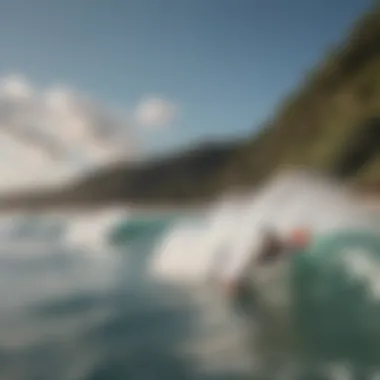
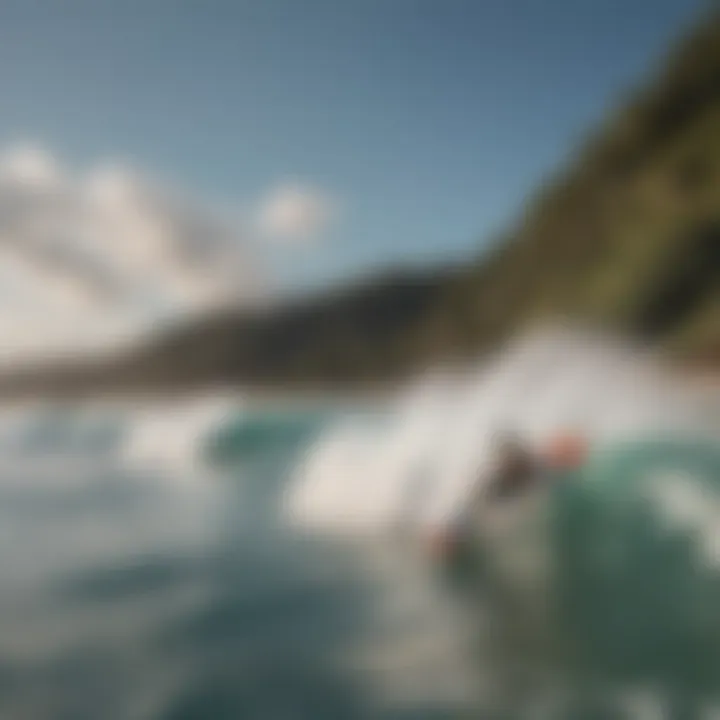
Intro
Bodyboard surfing, a captivating fusion of athleticism and artistry, invites enthusiasts into a realm where the ocean becomes a canvas for experience. This watersport transcends mere recreation; it embodies a culture intertwined with community, skill, and environmental awareness. Whether you are a novice keen to take your first plunge into the waves or a seasoned veteran looking to refine your techniques, understanding the nuances of bodyboard surfing is essential for maximizing your connection with the ocean.
When we delve into bodyboard surfing, we uncover a rich history that shapes its modern-day practices. From its humble beginnings to the thrilling competitions that now light up the global stage, this sport has evolved significantly. Equally important are the techniques and safety measures that not only enhance performance but also prioritize well-being in dynamic water conditions.
The equipment used in bodyboarding plays a pivotal role in both safety and skill development. Novices often face a bewildering array of gear options, while experienced bodyboarders continually seek the latest innovations to elevate their craft. Here, we will navigate through recommended gear, essential tips, and the community surrounding bodyboarding, tying together all aspects to encourage a deeper appreciation for this exhilarating sport.
Let’s start by discussing the pivotal pieces of equipment to ensure you have the right tools for a memorable experience.
Gear Recommendations
Essential Gear for Beginners
For those just starting out, getting the right equipment is crucial to enjoying your time in the water. You don’t want to be knee-deep in waves without the right gear. Here are some indispensable items every beginner should consider:
- Bodyboard: Choose one that fits your body size and riding style. A board that is too big or too small can hinder performance. Look for a softer board if you're a novice, as it provides more stability in the water.
- Leash: A sturdy leash keeps your board connected to you. This is vital for safety, as it prevents the board from drifting away.
- Fins: Swim fins help with propulsion and allow you to catch waves more efficiently. Ensuring a good fit is crucial so they don’t slip off unexpectedly.
- Wetsuit: Depending on your location, a wetsuit may be necessary to keep warm, especially in colder waters. Look for a thickness that balances insulation with flexibility.
Advanced Equipment for Professionals
As skills develop, many bodyboarders start seeking more specialized equipment. The right gear can significantly influence performance. Professionals often recommend:
- High-Performance Bodyboards: These boards are typically lighter and provide better maneuverability. Materials like polypropylene or PVC are common choices for a responsive ride.
- Tail Pads and Wax: Traction is critical at high speeds. Tail pads add grip, while wax ensures stability when you’re riding the wave.
- Impact Vests: These provide extra protection during more intense sessions or competitions—safety never takes a backseat.
- Custom Fins: Advanced riders may experiment with fin sizes and shapes to tailor their equipment precisely to their needs.
"The right gear can be the difference between a good session and a great one. It allows you to push your limits safely."
Arming oneself with the right knowledge about equipment sets a solid foundation in bodyboard surfing. Next, let's dive into the essential techniques and tips that can elevate your surfing experience.
Prolusion to Bodyboard Surfing
Bodyboard surfing is more than just a thrill; it's a lifestyle, an expression of artistry on the waves. Diving into this fascinating sport provides not only an understanding of the mechanics involved but also a glimpse into the culture that surrounds it. In this section, we aim to anchor our readers on the core elements that define bodyboarding and its importance, offering a foundation that will enhance their experience whether they are just starting out or are seasoned riders.
Defining Bodyboarding
At its simplest, bodyboarding involves riding a buoyant board while lying on your stomach, using your body to steer and control the board as you navigate the waves. However, the true essence of bodyboarding lies in the sensation of being one with the ocean. Many enthusiasts describe it as "dancing" with the waves, as they twist and turn, catching the swells that invite them. It’s a sport that requires not only physical skill, but also a deep understanding of the ocean’s rhythm—a blend of art and athleticism.
Origin and Evolution
Bodyboarding’s roots can be traced back to ancient Polynesia, where people rode waves on hand-crafted wooden boards. This practice evolved over centuries, with the modern form solidifying in the 1970s thanks to pioneers like Tom Morey. He created the first commercially successful bodyboard, allowing a broader audience to experience the thrill of wave riding. Since then, bodyboarding has seen a dramatic evolution in both technology and techniques, changing how enthusiasts interact with the surf. Today, advancements in materials and board design have made it accessible to all ages and skills.
The Distinction Between Bodyboarding and Traditional Surfing
While bodyboarding and traditional surfing share similarities, they each offer a unique experience. In bodyboarding, the rider remains closer to the water, which grants a different perspective and feel. Unlike surfers, who mostly stand, bodyboarders can perform tricks such as spins and flips with relative ease due to the board's design. Each sport has its fervent advocates, but the choice often comes down to personal preference. Both require a respect for the ocean and the skills to navigate its often unpredictable nature.
"No two waves are the same, and that's what keeps us coming back. Every session is a new adventure.”
In sum, understanding the key aspects of bodyboarding sets the stage for appreciating its beauty and complexity. This section enriches our journey through the sport’s nuances, leading into the exploration of the equipment, techniques, and community that define this vibrant world.
Essential Gear for Bodyboarding
Gear selection plays an astronomical role in bodyboarding, affecting performance, comfort, and safety. Choosing the right equipment isn’t merely a matter of picking what's trendy; rather, it involves considerations that can influence your overall enjoyment and success in the surf. Essential gear provides the crucial edge, whether you're aiming to catch your first wave or trying to perfect those advanced tricks.
Choosing the Right Bodyboard
Picking the right bodyboard is akin to selecting the right tool for the job. Each board has its features designed for specific conditions and riding styles. It’s not just about brand names; understanding the nuances can significantly uplift your performance.
Board Size and Shape
The size and shape of a bodyboard profoundly impact how it rides and how well it suits your style. For instance, shorter boards are more maneuverable, making them ideal for tricks and tight turns, whereas longer ones offer more speed and stability in larger waves. The width is also vital; a wider board offers better floatation, which is helpful for beginners. However, this might hinder advanced maneuvers. Ultimately, choosing the right size and shape should align with your goals and wave conditions.
Materials and Construction
The materials used in bodyboard construction influence durability and performance. Polyethylene and polypropylene cores are common choices, each offering distinct advantages. Polyethylene boards are best for colder waters due to their soft feel and great insulation. Polypropylene, on the other hand, is often favored in warmer climates, providing a stiffer feel and quicker response. It’s key to choose a board that not only resonates with your local conditions but also your personal preferences, which can range from paddle speed to wave control.
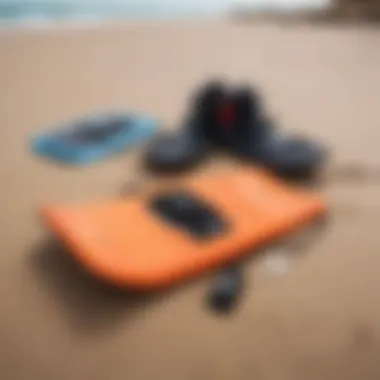
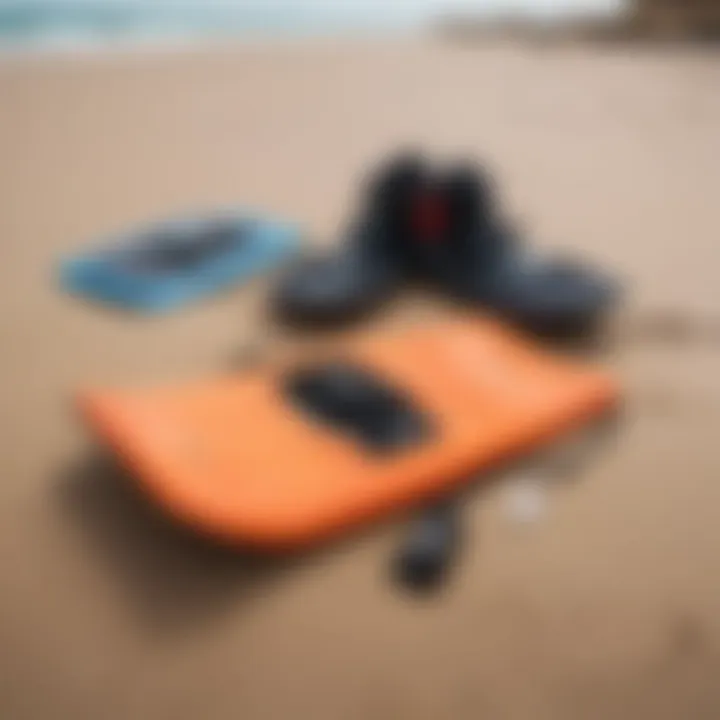
Tail Types
Tail design is often the underestimated aspect of bodyboards yet holds substantial importance. Different tail shapes cater to distinct riding styles. For example, a crescent tail allows for tighter turns, making it perfect for advanced riders looking to squeeze into barreling waves. Conversely, a square tail offers stability and ease, making it a wise choice for beginners still wrapping their heads around the basics of bodyboarding. Knowing which tail aligns with your riding style can elevate your experience.
Accessories to Enhance Performance
While the bodyboard itself is crucial, complementary accessories can enhance your performance and comfort in the water significantly. From fins to wetsuits, these elements can make a world of difference.
Fins
Fins are more than just accessories; they provide vital propulsion and control while you’re in the water. A good pair of fins can improve your paddling speed and help you catch waves more easily. Some fins come with specific designs like a soft rubber construction that can enhance comfort, making them more tolerable during extended sessions. However, it's essential to choose fins that don’t feel overly restrictive to avoid cramping or fatigue during those long rides.
Leashes
A leash is a small but critical component of bodyboarding. Keeping your board close at hand prevents it from drifting away after a wipeout, allowing you to recover it swiftly. The right leash should be made of durable materials to withstand the forces of the ocean. It’s beneficial because a reliable leash can save your board from being lost, which is a considerable expense. Consider choosing a leash with an adequate length to suit your riding style and the kind of waves you tackle.
Wetsuits
A wetsuit isn’t merely about fashion; it serves as insulation and protection from harsh environmental elements. In open water, temperatures can drop significantly and a good wetsuit keeps body temperature stable, allowing for longer, more enjoyable sessions. It's crucial to select a fit that isn’t too tight or loose—too snug can restrict movement, while too baggy may let in cold water. Also, different thicknesses cater to varying water temperatures, so choose wisely based on local conditions.
Maintaining Your Equipment
No matter how high-quality your gear, its performance hinges on how well you maintain it. Proper upkeep can enhance longevity and effectiveness, ensuring your bodyboarding experience remains top-notch.
Cleaning Techniques
Simple cleaning techniques can dramatically extend the life of your equipment. Rinsing your board, fins, and suits with fresh water after a surf session removes salt and sand, preventing premature wear. For wetsuits, a specialized cleaner can help maintain elasticity and lengthen wear time. Following these steps might seem minor, yet they serve as a long-term investment in preserving both aesthetics and functionality.
Storage Solutions
Adequate storage solutions can prevent unnecessary damage to your gear. When not in use, store your boards upright in a cool, dry place, away from direct sunlight, which can warp them. For wetsuits, hanging them to dry fully before storage can prevent mildew and damage to the neoprene material. A little foresight in storage goes a long way in preserving your equipment’s integrity.
Longevity Tips
Incorporating some longevity tips into your routine can be a game-changer. Regularly inspecting your gear for wear and tear can help you address potential issues before they escalate. Avoiding extreme temperatures during storage can protect your boards and suits from damage. These small but worthwhile practices can save you not only money in repairs but also enhance your overall surf experience, allowing you to focus on the joy of riding the waves.
"Choosing the right gear isn’t just about style; it's about enhancing your overall bodyboarding experience."
By ensuring you are well-equipped and focusing on the essentials, your bodyboarding journey can transform into one that is not only enjoyable but also rewarding.
Techniques for Effective Bodyboarding
In the exhilarating realm of bodyboard surfing, mastering techniques is akin to learning the language of the ocean itself. Techniques not only allow beginners to gain confidence in the water but also help experienced riders to push their limits and create memorable experiences. Developing a strong foundation in essential skills, refining advanced maneuvers, and adhering to safety protocols can drastically enhance one’s time spent riding waves. Each aspect contributes to a fuller understanding of how to interact with surf, which is ever-changing.
Fundamental Skills
Fundamental skills are the building blocks for any aspiring bodyboarder.
Positioning on the Board
Positioning on the board is critical. Getting this right can be the difference between slicing through waves like a hot knife through butter or tumbling head over heels in the surf. Ideally, your body should be centered, allowing for balance and control. A key characteristic of proper positioning is finding the sweet spot, which generally lies just behind the midpoint of the board. This not only improves speed but also stability—making it a popular choice among both novices and seasoned pros.
Unique to this technique is the way it affects your ability to steer and respond to wave dynamics. If done incorrectly, however, it leads to unwanted wipeouts. So, practice is paramount; spend time just getting used to the feel of the board beneath you.
Paddling Techniques
Paddling techniques influence your effectiveness when catching waves. A bodyboarder must master effective paddling, where your forearms move like a compass—steady and strong. Optimal paddling isn't just about brute strength; it’s about finesse. A key characteristic of good paddling is a relaxed yet vigorous stroke. This technique allows the rider to build up momentum while conserving energy for the ride ahead.
The unique element here is the angle of your arms during paddling. If your hands are too far back, you miss the precious seconds needed to catch a wave. While the advantages of good paddling are apparent—catching more waves, staying ahead of the surf—neglecting it can lead to frustration and fatigue.
Wave Riding Basics
Wave riding basics form the heart of bodyboarding. The thrill of being engulfed by the ocean’s power—there's nothing like it. To harness this energy, bodyboarders need to understand how to read waves. A key aspect is timing: knowing when to paddle and when to drop in will enhance your overall experience.
What sets wave riding apart is the relationship between the rider and the wave. Successfully riding a wave can feel like dance—a harmonious exchange of momentum. However, if you're out of sync, it can also lead to unexpected spills. Thus, focusing on wave selection and positioning will pay dividends.

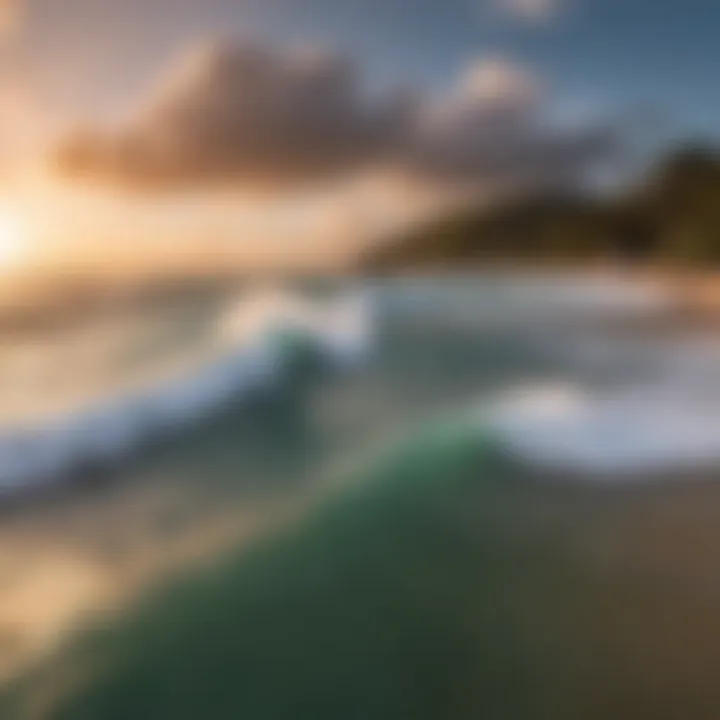
Advanced Maneuvers
For many, the world of bodyboarding is defined by the advanced maneuvers that can be performed once the fundamentals are mastered.
Barrel Riding
Barrel riding is the epitome of bodyboarding coolness: that moment when you slip inside the moving wall of water. It demands precision and boldness. One of its unique features is the rush it offers, often resulting in a euphoric sense of accomplishment.
The key characteristic here is the split-second decision-making: whether it’s the right moment to go inside or to kick out. While thrilling, the disadvantages involved in barrel riding can be considerable, particularly the risk of injury if not approached with caution.
Air Maneuvers
Air maneuvers elevate you above the water—the ultimate demonstration of skill and poise. These tricks, such as airs and flips, build confidence while showcasing a rider's proficiency. The characteristic of making the board defy gravity for that brief moment not only exemplifies skill but pushes the boundaries of bodyboarding.
Air maneuvers add a layer of complexity, as timing and body positioning become crucial factors. If executed improperly, these can lead to awkward landings and potential injuries. Still, the satisfaction of perfecting an air maneuver can often outweigh the risks.
Tricks and Spins
Tricks and spins inject flair into a ride. From simple spins to complex flips, these skills are designed to impress. The dynamic nature of tricks means they can be adapted to different conditions, allowing riders to express their creativity.
What makes this characteristic stand out is its accessibility; almost anyone can learn to do simple spins. That said, advanced tricks require time and commitment. The unique challenge lay in balancing between style and efficiency—overly dramatic tricks might detract from the wave ride experience itself. Therefore, it’s essential to practice tricks in less crowded conditions to avoid unnecessary trips to the doctor.
Safety Protocols
Safety protocols can often be the unsung hero of thrilling sports like bodyboarding, ensuring the fun doesn’t become dangerous.
Recognizing Dangerous Conditions
Recognizing dangerous conditions is crucial for any water sport enthusiast. Knowing how tides and swells behave can save lives. A key characteristic is the ability to interpret visual cues in the water and potential hazards along the shore. With this knowledge, bodyboarders can make informed decisions about when and where to ride.
A unique aspect of this is not just reading the ocean but understanding your own limits. Ignoring signs or the power of the surf can lead to dire consequences. Thus, honing this skill is not just beneficial—it’s essential.
Personal Protective Equipment
Personal protective equipment (PPE) acts as a first line of defense. From padded shorts to helmets, these accessories help mitigate injuries during chaotic wipeouts. The key element here is awareness—wearing appropriate gear shows foresight and concern for personal safety.
However, some riders shy away from using PPE due to comfort levels or aesthetics. It’s vital to weigh the advantages of protection against these concerns. Over time, wearing the right gear will become second nature, ensuring safety while maximizing enjoyment.
First-Aid Basics
First-aid basics equip bodyboarders to respond effectively in case of mishaps. Understanding how to administer basic first aid can turn a potentially tragic scenario into a manageable situation. The key characteristic of first aid is its accessibility; simple techniques can often be learned through courses or local clubs.
The unique beauty here is being prepared, fostering a sense of security when in shared waters. However, neglecting this knowledge can lead to disastrous outcomes during emergencies, particularly when help is far away.
"Safety should never be viewed as an option, but rather a responsibility of every bodyboarder hitting the waves."
In sum, mastering effective techniques in bodyboarding transforms not just individual performance but how one interacts with the ocean. From foundational skills to advanced moves and vital safety considerations, the journey involves constant learning and growth. The thrill, while undeniable, exists alongside the necessity of respect for the ocean’s power.
Bodyboarding Culture and Community
Bodyboarding isn't just a sport; it's a way of life for many. The culture surrounding bodyboarding fosters a sense of belonging, where enthusiasts—from rookies to seasoned pros—come together like waves crashing on the shore. This community isn't just a support network; it's a vibrant global scene filled with shared experiences, saltwater adventures, and rooted traditions.
Engagement in local and international bodyboarding communities enriches one's understanding and appreciation of the sport. Learning new techniques, sharing stories, and picking up on the latest trends can elevate one’s experience in and out of the water. Moreover, immersing oneself in these communities helps nurture friendships that often extend beyond the ocean; they cultivate an atomosphere where like-minded individuals encourage growth and foster a spirit of camaraderie.
The Global Bodyboarding Scene
A dive into the world of bodyboarding naturally leads us to its diverse and dynamic scene across the globe. Each coast offers a unique flavor of the sport, creating a patchwork of cultures and practices that intertwine with the sport’s evolution.
Key Locations for Bodyboarding
When discussing key locations for bodyboarding, places like Nelscott Reef in Oregon, Lifeguard Tower in California, or Teahupo'o in Tahiti come to mind. These sites are not just popular due to their renowned waves but also because they embody a certain character. Each spot offers its unique challenges and rewards, catering to varying levels of skill.
What sets these locations apart is the consistency of the waves, the breathtaking landscapes, and the local bodyboarding culture that often welcomes newcomers. However, these aren’t just vacation spots; they can also be harsh environments where experience and knowledge trump enthusiasm. Newcomers must learn to respect the ocean and the local community to truly appreciate these surfing jewels.
Influential Riders and Events
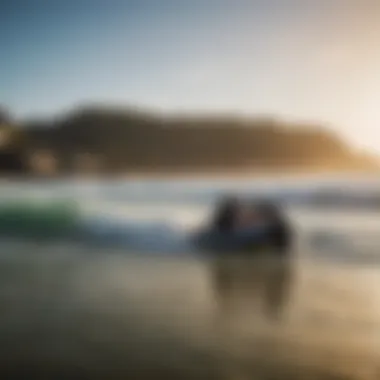
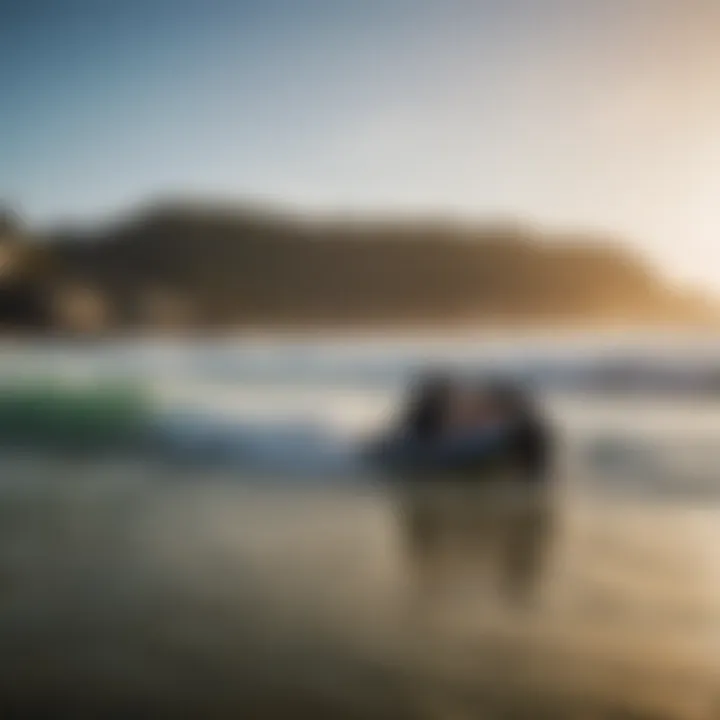
Prominent figures in bodyboarding, such as Mike Stewart or Guilherme Tamega, have become symbols within this culture. These riders have pushed the boundaries of what is possible, inspiring countless others to pick up a board.
Events, like the IBA World Tour, are not just competitions but celebrations of skill and community. They bring together riders from diverse backgrounds, showcasing the best talent the sport has to offer. The excitement and intensity surrounding these events often invigorate local cultures, creating a buzz that encourages more people to join the ranks. Competitors face tremendous pressure, but they also gain invaluable insights from these experiences.
Social Media and Online Communities
In today’s digital age, platforms like Reddit and Facebook have fostered bodyboarding communities that transcend geographical boundaries. These online spaces allow bodyboarders to connect, share videos, and discuss gear or techniques worldwide. They also serve as a repository for invaluable knowledge passed down among newer riders, and these shared experiences enrich the culture further.
However, while social media can connect fans and enthusiasts, it can also lead to a filtered reality, where the challenges and struggles of bodyboarding might be overlooked. Nevertheless, these platforms remain crucial for fostering community ties and igniting a passion for the sport.
Environmental Responsibility
Bodyboarding doesn’t exist in a vacuum; it operates within the intricate framework of beach ecosystems. As conscious participants, bodyboarders have a duty to understand and protect these environments.
Understanding Beach Ecosystems
Diving into the ocean means immersing oneself in an intricate ecological system that deserves respect and care. Each beach has its flora and fauna, influencing not just the experience of riding waves but the overall health of our planet. Educating oneself about these environments can enhance one's appreciation for them and encourage sustainable practices.
Responsibility comes not just from knowledge; it's also about actions taken to protect these precious ecosystems from pollution and degradation.
Sustainable Practices
Adopting sustainable practices is crucial in minimizing the impact on the oceans and beaches we love. Simple actions, such as using eco-friendly products and minimizing plastic waste, can make a substantial difference. Many riders practice leaving the beach cleaner than they found it, which not only preserves the environment but also sets an example for newcomers.
Nonetheless, these practices can sometimes feel cumbersome or intrusive, leading to hesitance among new bodyboarders. Education and advocacy can help bridge the gap, making sustainable choices the norm rather than an exception.
Advocacy and Volunteering
Engaging in advocacy and volunteering for beach cleanups or environmental initiatives strengthens the bodyboarding community. These efforts are often led by local organizations that recognize the sport's connection with the natural environment. By participating, bodyboarders advocate not only for their sport but for the habitats that support their passion.
It's a win-win situation that nurtures both the sport and the beaches. However, the challenge remains in maintaining motivation and commitment among the members of the community who may feel overwhelmed by the scale of environmental issues.
The Role of Competitions
Competitions are often the lifeblood of any sport, providing a platform for skills to be showcased and aspirations to be fulfilled. Bodyboarding events are more than just contests; they are gatherings that bring treasure troves of experience and learning.
Types of Competitions
Different types of competitions exist within the bodyboarding realm, from local contests held at familiar beaches to grand international championships. These events cater to various skill levels and can be individually or team-based. Most importantly, they create a stage for riders to test their skills against others and improve.
However, this competitive aspect can lead to pressure or anxiety for participants. It’s essential for riders to find balance and prioritize passion even amidst competition dynamics.
Preparation for Events
Preparing for competitions goes beyond just physical training. Mental preparation stands just as important; riders must develop strategies to manage nerves and visualize their runs. Many bodyboarders adopt routines that include reviewing their performance, practicing in similar conditions, or using mindfulness techniques.
Yet, this preparation takes time and effort, which can pose challenges, especially for those juggling jobs or studies alongside their passion for bodyboarding.
Lessons Learned from Competition
Competitions offer invaluable lessons, whether through victory or defeat. Riders often reflect on their experiences, identifying areas for self-improvement or new techniques to integrate into their repertoire. Learning to cope with loss and celebrating successes can contribute to personal growth, shaping one’s character on and off the waves.
Participating in competitions nurtures resilience, determination, and a sense of community—elements that keep the culture of bodyboarding alive and thriving.
Epilogue
As we wrap up our exploration of bodyboard surfing, it’s essential to reflect on the various dimensions of this thrilling sport. Bodyboarding isn’t just about catching a wave; it’s a multifaceted experience that merges skill, passion, and community. The closing thoughts on bodyboarding highlight key elements such as the equipment used, developing techniques, and the importance of environmental stewardship.
Reflecting on the Bodyboarding Journey
Looking back at one's journey in bodyboarding evokes a sense of personal growth and thrill. Each session on the water is a stepping stone, teaching valuable lessons both in and out of the surf. Many bodyboarders will recount their first wave—the adrenaline rush, the connection with nature, or perhaps, the inevitable wipeout. These memories, vivid and often cherished, form the foundation of one's dedication to the sport.
Every bodyboarder experiences a distinct path, shaped by unique challenges and victories. Progressing in bodyboarding translates not only into skill mastery but also fosters resilience. The countless hours spent mastering wave dynamics and perfecting maneuverers create a bond between the rider and the ocean. It's the connection with fellow riders that cultivates a strong community, further enriching this journey. By sharing stories, tips, and encouragement, bodyboarding fosters relationships that can last a lifetime.
Future Trends in Bodyboarding
As we peer into the horizon of bodyboarding, it’s fascinating to consider the trends that may shape the sport.
- Sustainable Practices: The emphasis on protecting our beaches and oceans has never been more relevant. Bodyboarders will increasingly advocate for sustainability, pushing for eco-friendly gear and practices.
- Technological Advancements: Innovations in materials and designs will continue to influence board construction, making them lighter and more responsive. The integration of smart technology could also provide tailored performance feedback via wearable devices and apps.
- Accessibility and Inclusivity: There’s a growing movement towards making bodyboarding accessible to everyone, regardless of skill level or physical ability. Programs that encourage participation across diverse demographics will, hopefully, broaden the community.
- Emerging Destinations: With climate change influencing surf conditions, new locations may rise in popularity, changing the geography of bodyboarding hotspots around the world.
In wrapping up, understanding the past and present of bodyboarding paves the way for future innovations and growth in the sport. The importance of reflection cannot be overstated; it fuels our passion and motivates the bodyboarding community towards an exciting future.















